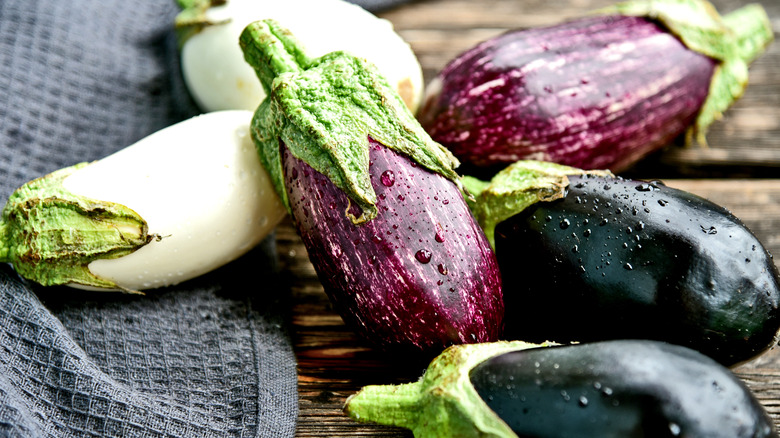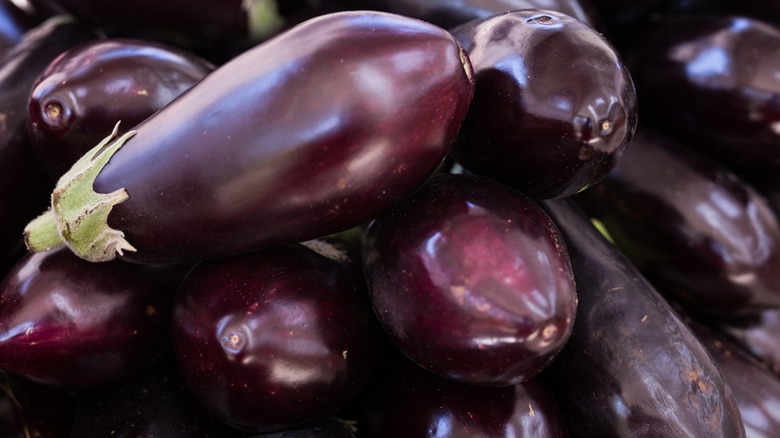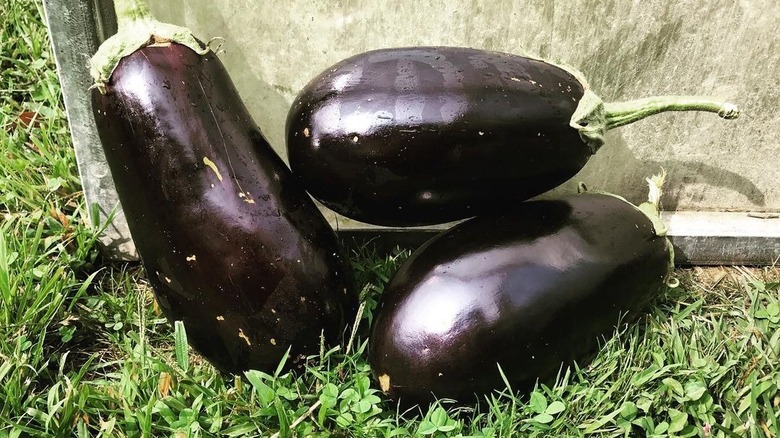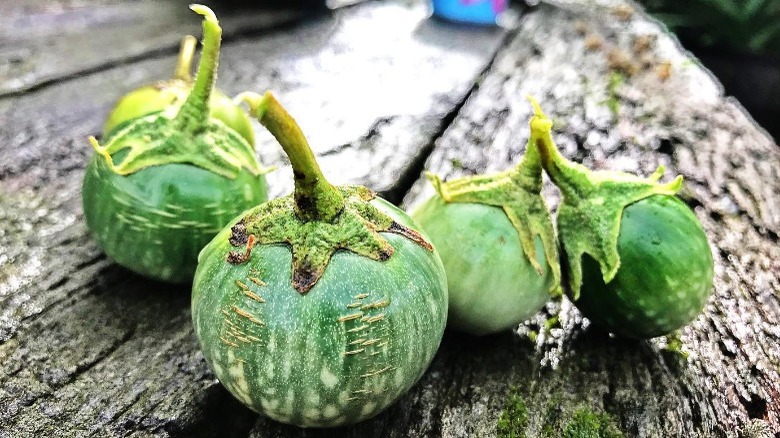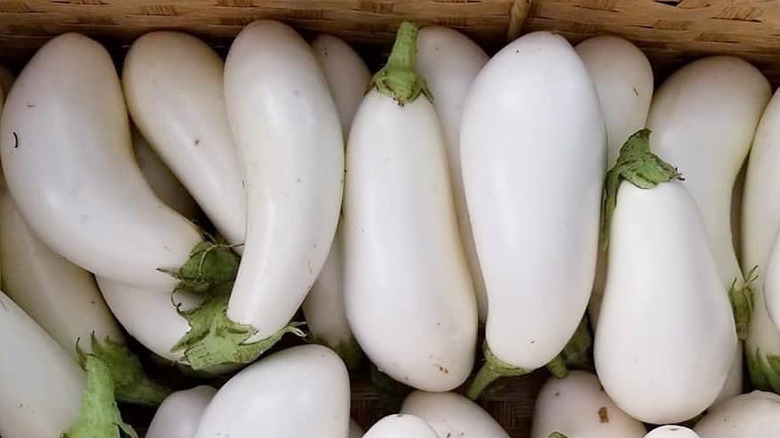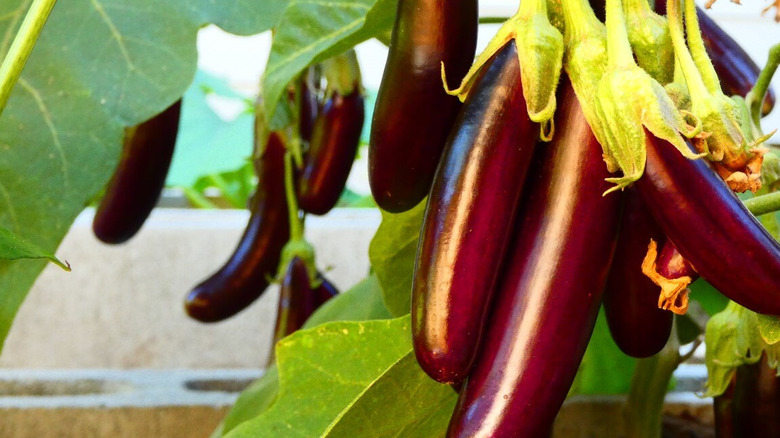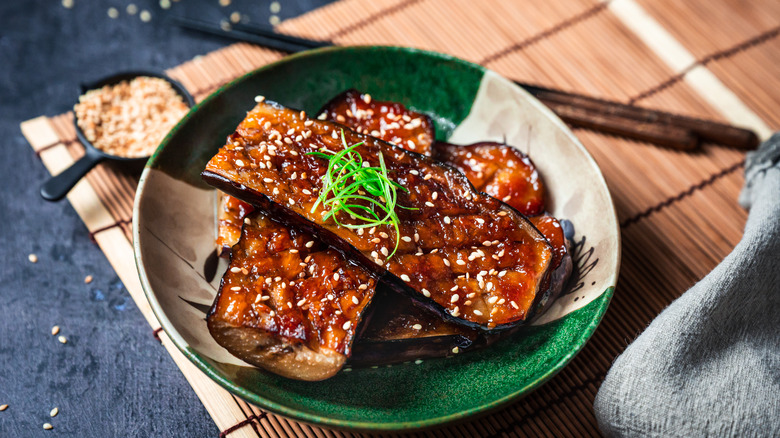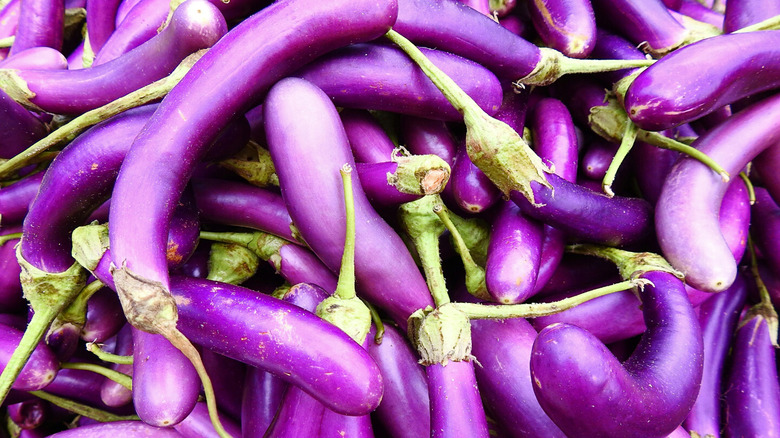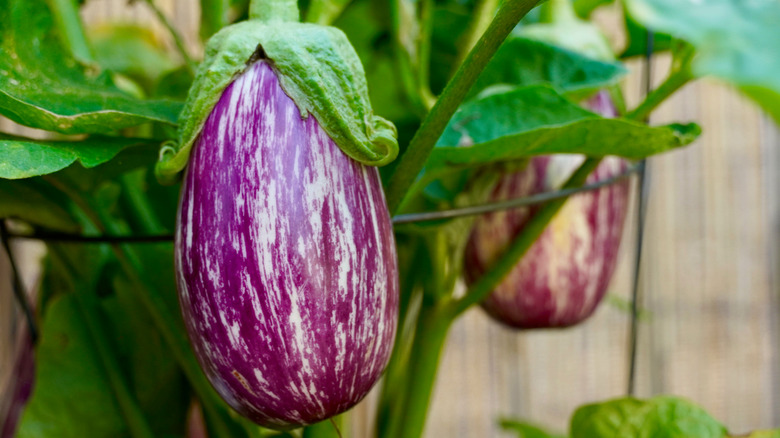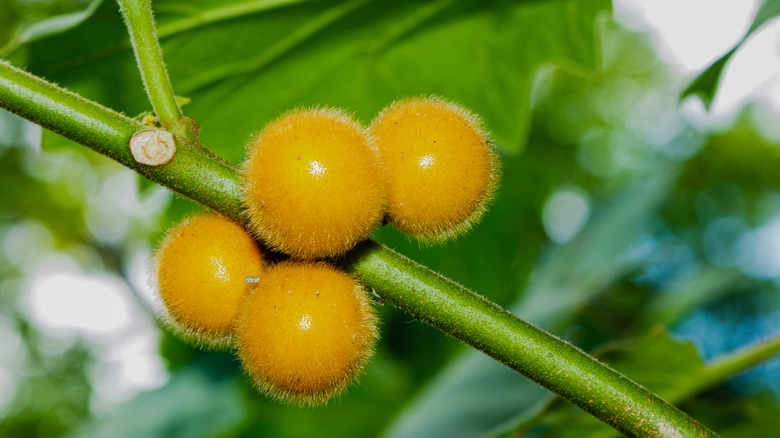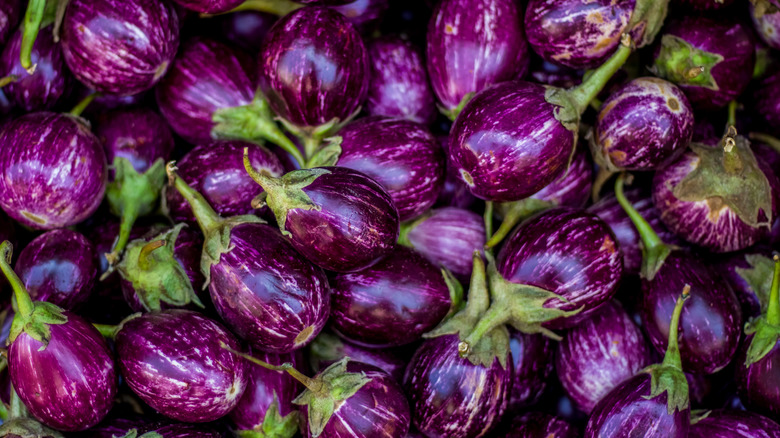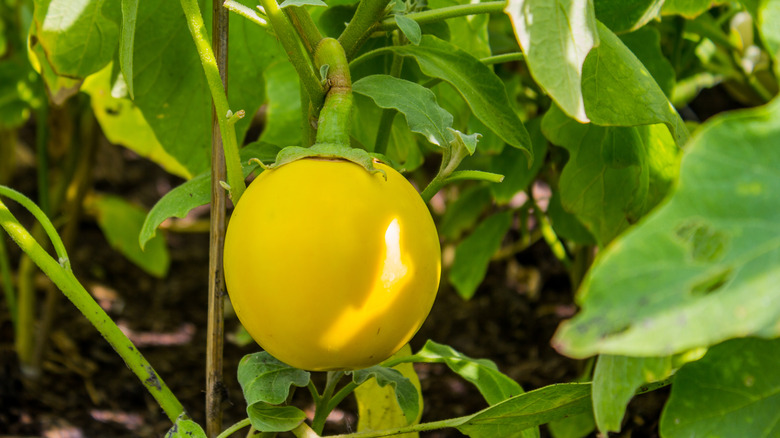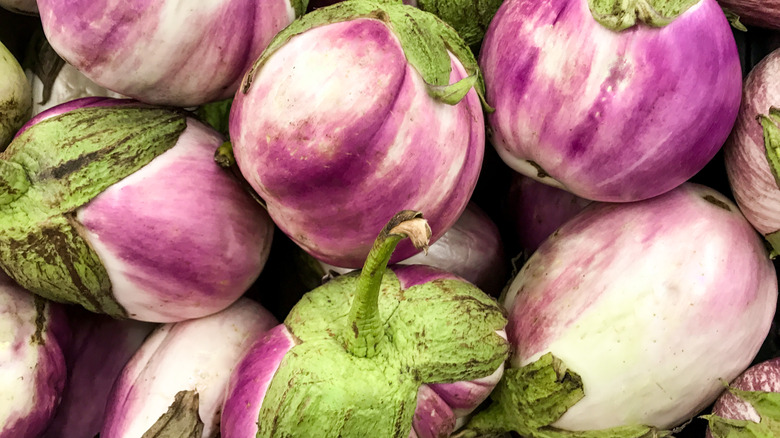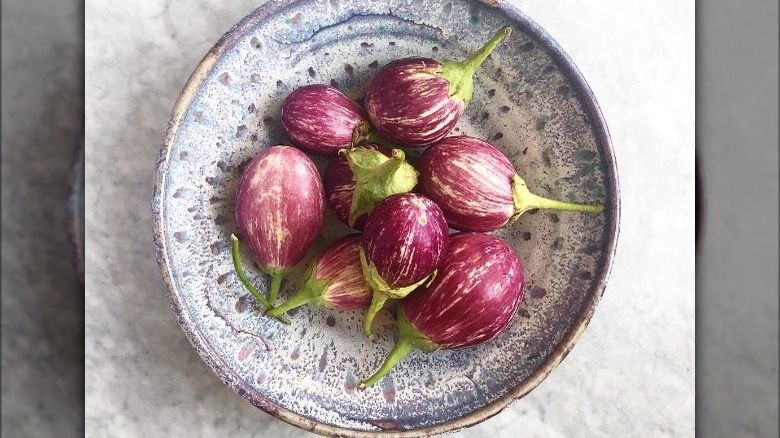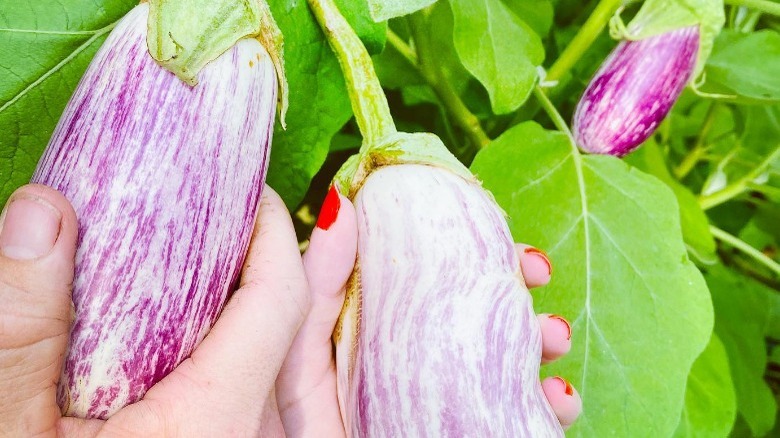15 Types Of Eggplants And How To Use Them
We may receive a commission on purchases made from links.
Eggplants are pretty commonplace, right? Nowadays at least, they're far from exotic. From bursts of purple in the produce section to filling plates of eggplant parmesan and baba ganoush — not to mention in the digital sphere as the eggplant emoji — they are everywhere.
The fact that eggplants are so omnipresent in the United States is the result of a thousand-year history of intrigue, delight, and deliciousness. The fruits (also known as aubergines) are thought to originate in Southeast Asia but have since been cultivated around the world with success (via BBC Good Food). But there isn't just one type of eggplant, though only one might come to mind. As the eggplant has traveled through different regions, continents, overseas, through time, and cultures, it has been adapted to suit different climates and cuisines.
There are some rules to play by and patterns to follow. North Carolina State University highlights that although the fruit can be eaten, the rest of the plant is more often than not poisonous. BBC Good Food also observes that eggplants take on a unique creamy texture under heat, with a complex flavor that straddles the line between smoky, savory, and sweet.
There's a distinct richness to eggplants in all of their many varieties. Even the most familiar types can become exotic under the right conditions. Here are some common (and not-so-common) types of eggplant and what they're best for.
Globe eggplant
The globe eggplant is probably the most familiar type to Americans. While the Emoji Guide doesn't cite any specific eggplant variety as the inspiration for the eggplant emoji, it's hard to ignore its resemblance to a classic globe eggplant. The American globe eggplant is characterized by a glossy rich purple color and creamy white flesh, as Specialty Produce describes. The dark purple ovular body is topped with a bright green stem.
In the culinary realm, Fine Cooking makes the point that at least among American consumers, the globe eggplant is one of the most common varieties. Despite its familiarity, there are still a few tips to know when preparing this delight. Though it can be found in grocery stores year-round, the globe eggplant is at its peak in late summer.
At their best, eggplants are creamy, which Fine Cooking notes can be amplified by peeling the rough skin off. It's also best to salt the eggplant before cooking to eliminate bitterness and break down any air pockets, preventing an overly greasy result if you're cooking them in oil. If you're looking for a fun use for globe eggplants, try our caponata recipe.
Nadia
Traditional Italian Nadia eggplants are the same shape as American globes, albeit smaller and glossier. Specialty Produce says they typically have dark indigo, bordering black skin. Compared to other varieties, Italian eggplants have thinner, finer, skin and rarely have blemishes (via Gardening Know How). Meanwhile, their flesh is porous and close to sponge-like in nature.
What sets the Nadia eggplant apart from other Italian eggplant varieties, according to Gardening Know How, is its small stature. This eggplant is petite and ready to eat, and its smaller size allows for comparably quicker roasting. Much like with globe eggplants, this texture turns creamy when prepared and cooked well. It also allows the vegetable to easily take on many different flavorings. Specialty Produce recommends sautéing cubed Nadia eggplant in garlic for a delicious taste. For those interested in bringing eggplants into both the kitchen and the garden, Nadia's small stature lends itself well to smaller spaces and even containers.
Thai
They may look more like pumpkins, but these are all eggplant. In the same vein as Nadias, Thai eggplants are among the smallest, if not the smallest, eggplant variety. Averaging around one inch in diameter, Thai eggplants are truly bite-sized (via Specialty Produce). These eggplants are green in color, giving way to creamy stripes at the base. The shape is notably rotund and the flesh has a slightly crunchy texture.
Like most eggplants, without any additional cooking or flavoring, these have a mild bitterness. Thai eggplants have creamy innards, albeit with many brown seeds. As Specialty Produce points out, this variety is a rarity in that it can be consumed both raw and cooked. Keep in mind that raw Thai eggplants have a certain edge to them. This isn't necessarily a bad quality, and can they add an extra twist to salads and crudités
Thai Cookbook asserts that the Thai eggplant is quintessential to Thai cuisine, specifically in curries. Besides being whipped into traditional dishes, this variety does well served tempura-style.
Snowy
White eggplants may look drastically different from their purple counterparts, but they're not really worlds away from each other. For those who still have not gotten their sea legs in the magnificent world of eggplants, the biggest and most important distinction between white and purple eggplants is their color (via Waves in the Kitchen). Looks aside, white eggplants tend to be creamier, less bitter, and a bit more delicate in taste than their purple counterparts. They are also typically smaller than purple eggplants, though of course there are exceptions.
Snowy white eggplants are just one variety among many and tend to be ovular and medium in size (typically 20 to 25 centimeters in length). With a brilliant white color offset by a green stem, snowy white eggplants are creamy, firm, and meaty (via Specialty Produce). While purple eggplants can be cooked with the skins on, white ones usually have such firm skins that they must be peeled.
White eggplants can be prepped in a number of ways. Deep-frying them creates a particularly pleasant contrast of crunchy and creamy consistencies. They are so meaty that they work well as a meat substitute and can make even the most meat-heavy traditional Italian dishes plant-based. They really are perfect in the kitchen.
Little fingers
As you might be able to tell from the name, little fingers are a tiny eggplant variety. This variety is so thin that the name really does them justice — they do indeed look like little fingers. As observed by SFGate, the average little finger eggplant is 4 to 7 inches long. Little fingers are perfect for small-scale cultivation in containers, on balconies, and in small gardens. Though of course, the plant's dramatic foliage and bright fruit make a splash even in bigger gardens.
Little fingers eggplants may be tiny, but they sure are knock-outs. According to Urban Farmer, the petite eggplant's size not only lends it well to urban cultivation but also to grilling and other cooking methods. Due to the size and thinness of this variety's skin, it need not be peeled. When cooked, its flesh turns silky smooth. This variety is mildly sweet, but its texture is really the thing to write home about. The real challenge is perfecting the grill time so as to not overcook these dainty delights.
Japanese eggplant
According to the Specialty Produce, eggplant is one of the most popular vegetables grown in Japan. The fruit was introduced to Japan in the eighth century. Longer, thinner, and sleeker than Italian or American eggplants, Japanese eggplants are hard to confuse with other varieties. Despite these differences, Japanese eggplants still have the classic purple body/green stem color combination as the common eggplant. Japanese eggplants generally measure 20 to 25 cm in length. Their sleek and glossy finish does however come at a price: These eggplants bruise much more easily than thicker-skinned types. Taste-wise, Japanese eggplants were bred over time to be extremely spongy and sweet, with earthy and vegetal notes. Because of this variety's thinness and its lack of seeds, it does not need to be salted, unlike larger eggplant varieties.
With such a long history, and with such specific breeding surrounding this variety, it makes sense that the Japanese eggplant has a special place in Japanese cuisine. The dish nasu dengaku, pictured above, is an especially mouthwatering recipe that uses grilled or deep-fried thin eggplant and covers it in a complex sweet and savory miso glaze.
Chinese eggplant
Similar to Japan, China has long loved eggplant and bred the plant for so long that there is a specific Chinese variety of eggplant. There is some discourse if the eggplant was first imported to China from India or if it truly is fully native to the region, but it has undoubtedly been in China for a long time (via Specialty Produce). Similar to Japanese eggplants, Chinese eggplants are long, lean, meaty, and very crucially have fewer seeds than their Italian and American counterparts, as described by Nature's Produce. Unlike Japanese eggplants, Chinese eggplants tend to be much lighter in color and are primarily found with bright lavender skin and creamy white flesh. Chinese eggplants can be used interchangeably with globe eggplants in similar dishes, though we should note that Chinese eggplants are mostly sweeter than their North American counterparts.
As noted above, because Chinese eggplants have fewer seeds than other varieties, they do not need to be salted to remove any overwhelming bitterness when picked fresh. That being said, when buying a Chinese eggplant at the store or farmer's market, after it's had time to sit and mature, salting can work as a preventative measure to ensure that the dish is as sweet and flavorful as it can be. Specialty Produce does note that Chinese eggplants respond very well to braising, stir-frying, and sautéeing.
Graffiti
Arguably the prettiest graffito of them all, the graffiti eggplant is hard to forget and impossible to ignore. The graffiti eggplant is bright purple and white in color with "random" markings, as described by Produce Market Guide. As Frieda's points out, although this eggplant got its start in the Mediterranean, it is now predominantly grown up north in Holland.
The graffiti eggplant variety is notably sweet and, as Produce Market Guide notes, is much more flavorful than other varieties of eggplant. It doesn't only make its mark visually so to say, there is a definitely something here beyond the palate for the palate. Despite its unique appearance and flavor, it cooks very similarly to any other globe-shaped eggplant and can be used in any recipe that calls for one. Do note, however, that this variety is considerably smaller than other Italian eggplants. Considering its roots, one may say it's safe to incorporate this beauty into Italian recipes, but its small size may mean using double graffiti. After all, you don't want this visually-rich eggplant to leave you physically hungry. Graffiti eggplant is at its freshest in the summer and first few months of autumn.
Cluster eggplant
They might be confused for raw cherry tomatoes at first sight, but cluster eggplants are bite-sized eggplants that have long held a star in Thai cuisine, according to Specialty Produce. That being said, this eggplant got its start far away from the depths of Southeast Asia, and some botanists theorize that the cluster eggplant originated in South America or Africa. As the site notes, it could even be that the cluster eggplant is the closest surviving relative of the wild eggplant.
This eggplant is visually similar to grapes and ripens with thin light green to yellow skin. One cluster eggplant fruit can hold around 200 seeds, which leads to the morsels being considerably tart if not downright bitter. That being said, in Thai cuisine, cluster eggplants can be found enjoyed both raw and cooked. Specifically, the Thai dish nam prik kapee, a chili and shrimp paste blend, usually includes cluster eggplant. One might be surprised that there are ways to incorporate these eggplants into traditional Southern or Southwestern cooking, but as Preppings advises, cluster eggplant can be used to replace tomatillo and green tomato and vice-versa.
Hairy eggplant
This name describes the plant perfectly. That being said, there are many other names, including Coconilla, Bura-Bura, Bolo maka, Cocochat, Pupu, Tupido, Pimpla, and Tupirito, but you can just call this eggplant hairy (via Specialty Produce). No matter the name, what stays the same is the content. The hairy eggplant has a unique tropical flavor. In fact, this is a tropical plant and its origins have been traced back to the West Indies, though it has been naturalized throughout the Southeast Asian region.
Hairy eggplants start out green but will ripen into a bold yellow to orange color as they become ready to eat. When ripe, hairy eggplants have a distinct floral taste with a simply scrumptious crunch to each bite. Because of this unique flavor composition, hairy eggplants can be eaten raw or cooked, though one needs to always bear in mind to shave, or boil, the hair off of this hairy eggplant. While some might be put off by sweet tanginess of this eggplant, it can be found everywhere from sauces to condiments and even the above-mentioned chili-shrimp blend. There's one more heavenly application for this exemplary eggplant: Rare Palm Seeds advocates that the sour aroma of this variety balances out fish specifically and spectacularly.
Indian eggplant
As mentioned above, eggplants have long held importance in Indian cuisine. In fact, some believe that eggplants might have originated in India (via ThoughtCo). Next to China, India is the largest producer of eggplants, to the point where the plant can be considered a "staple" produce (via Specialty Produce). It is fitting, of course, then that there is an eggplant that is both native to and specifically cultivated on the subcontinent, namely the Indian eggplant. Indian eggplant is a smaller variety, reaching only 5 to 7 centimeters in length, which is why it is often referred to in many stores as a "baby eggplant", even though it is fully ripe. These eggplants are bulbous, almost egg-shaped, with a glossy dark purple skin. Their flesh is porous, crisp, and creamy white in color.
Indian eggplants have much fewer seeds than globe and Italian eggplants. That means that, once cooked, Indian eggplants are creamy and noticeably sweet. As noted by Specialty Produce, because of the shape and size of the Indian eggplant, it is perfect for whipping up a stuffed eggplant recipe. When making bengan bhartha, a sort of Indian baba ganoush-esque dish, there is simply no other eggplant that will do to make this dish sweet and tender.
Baby yellow eggplant
This ovular yellow eggplant is a star in its own right, and can also be found under the extremely poetic and fitting name golden egg, though baby yellow eggplant is just as common. When talking size, it doesn't get much smaller than this baby, measuring 5 centimeters max in diameter (via Specialty Produce). Baby yellow eggplants, as one might be able to guess, have a deep golden yellow color once ripe, though they'll carry a startlingly white color up until the point when they ripen. They have creamy yet crunchy white flesh. Unlike the previously mentioned Indian eggplant, the yellow eggplant is extremely bitter in taste. This is easily remedied with a little heat applied in the form of sautéeing, frying, or roasting.
Two additional steps should be taken for this supremely bitter eggplant: One, make sure to remove the eggplant's seeds, which are pretty hard to miss as they are large and dark brown. Once the seeds are removed, soak the eggplant in water to remove the astringent flavor. After that hurdle is cleared, the world is really your oyster. FreshPoint suggests an array of combinations for the bright and bold bay yellow eggplant, including feta, gruyére, red wine vinegar, basil, and summer squash to name a few.
Rosa Bianca
A treat from the southernmost tip of Italy, Rosa Bianca eggplants are as sweet as they are bright. The name Rosa Bianca alludes to the produce's unique coloring, a bright pink to lavender with shading that almost resembles an ombre. Despite this eggplant's beauty, according to Thrive Cuisine, the origins of this variety still lie in relative obscurity. While much about its past remains unclear, it is known that this particular eggplant reached the States for commercial wholesale at the turn of the century. Since then, this eggplant has really taken off. But there's more to this eggplant than its good looks.
As Rare Seeds notes, this eggplant has long been a favorite among hobby gardeners and chefs alike. Though this eggplant measures up to 4 to 7 inches in length, it still maintains a supremely sweet flavor with little to no detectable bitterness, all the while showcasing the quintessential mild sweetness and creaminess that has long made eggplants a staple.
Nubia
Another Italian variety, Nubia eggplants are beauties made unique by their white stripe mottling. This heirloom variety is both oblong and girthy. Suffice it to say, there's a lot of good stuff going on here. Gardening Know How sings praise for this eggplant, which they describe as both sturdy and very simple to cultivate in the garden.
This easy-going nature carries over to the kitchen, and the gardening site aptly describes this eggplant's flavor as mellow, which lets it play well with a wide spectrum of flavors and foods. Smart Gardener recommends really leaning into the Italian direction and pairing Nubia with soft Italian cheeses like ricotta, Parmesan, and mozzarella, to name a few. Its longer size, measuring around 7 to 8 inches in length, makes it an apt choice for grilling as well. With its unique appearance, similar to the Rosa Bianca, and its mild flavor, it really is versatile in cooking.
Antigua
Antigua eggplants are beautiful and lend themselves well to traditional eggplant cooking. Reimer Seeds notes that the Antigua eggplant is snowdrop shaped with violet and lilac stripes. Antigua eggplants are another heirloom variety cultivated here in the United States, and can be found in both farmer's markets and grocery stores throughout the entirety of the summer season. Phytoteca also notes that because of the plant's compact size, it can be cultivated in a wide array of spaces relatively simply. For those who want their eggplants straight from the garden, look no further.
As Reimer Seeds advises, these eggplants are at their best and most brilliant at 6 inches long, so make sure to harvest or buy around this size. Antigua eggplants are really a culinary delight. They have almost no detectable bitterness. This special variety really does offer all the creaminess of a classic eggplant with a much milder taste. For those who value texture, this is the best bet, if you can find it, that is.
